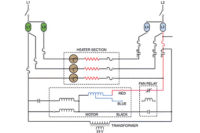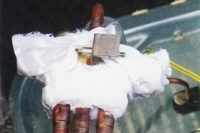Now, Bob’s company has promoted him to help train a new employee, right out of a school specializing in HVAC, just like Bob was. Bob is now Tim’s Btu Buddy. Tim is anxious to travel with Bob. Tim realizes that he is right out of school, with the theory and lab work that he accomplished in school, but still needs help. He knows that he worked with many of the components of the systems in the school, under ideal conditions with good light and air conditioning. Now it is into the field, sometimes under the house with poor lighting, or out on the rooftop in the sun, where the real action is. He is naturally and normally reluctant, but he has Bob to help guide him.
Bob and Tim were taking a break and Bob began explaining some of the tips that he has learned in servicing heat pumps.
Bob said, “Let’s go over some of the service problems that you may have with a heat pump. I want to start with mentioning some things that will cause the customer’s electrical bill to rise excessively. Nothing will prompt a customer to call faster than ‘no heat’ unless it is an electric bill that is excessive.
“One of the first things to remember is that the indoor coil is a condenser during the winter cycle. Any time air is restricted to the indoor coil, head pressure will rise. It doesn’t take much of a restriction in the airflow across the coil to cause a serious rise in head pressure, which will cause the system to lose heating capacity and cause it to run longer. Longer run times for the same amount of heat will cause a rise in power consumption.”
Tim said, “It looks like there should be some kind of alarm system to prevent this from happening.”
Bob responded, “Modern electronics are now able to take care of this type of malfunction as well as some of the more common problems and furnish an alarm code to the indoor thermostat. These electronic monitoring systems are typically found on the higher priced units. The homeowner can look at the code and call for service. The difficulty with these kinds of problems is that the system controls almost need be able to think. Logic circuits are now able to take readings from sensors and determine there are problems and what the nature of the problems is. The service technician can often know what the problem is before getting to the job.”
Tim asked, “Where is the best place to get the information to be able to read these codes?”
Bob said, “The trouble code is often written in the thermostat or it may be a series of blinking lights and the code written in the thermostat or in the cover of the air handler or the condensing unit.
“You should attend service schools that the manufacturers host. Most manufacturers try to have their schools for their dealers and it is sometimes hard to get an invitation. There are still many heat pumps that do not have the sophistication of modern electronics.
“One of the first things to check out for any heat pump is the airflow. A visual check can often turn up malfunctions before they become a problem.
1. Make sure the air filter is clean and fresh at the beginning of the season and check them on every occasion you have.
2. A visual inspection of the coil is a good idea any time you get the chance.
3. A visual inspection of the fan wheel is another procedure that should be done every year. If the fan wheel has a buildup of dirt, it must normally be removed and cleaned (Figure 1). Most fans draw air through the filter and the coil. If the fan wheel is dirty, the coil interior is dirty. The coil is a super filter in the summer when it is wet with condensate. Dirty air will load the coil interior with dirt that must be washed out.
4. Do a room to room inspection of the registers to make sure they are all open. People have a tendency to close them off to keep from heating or cooling a room. This oftentimes reduces the airflow enough to cause a problem.
5. Oftentimes, furniture is set in front of or over a return air grille. Grilles must have full flow for proper airflow. There can be a draft around a return air grille that the homeowner tries to reduce with a throw rug or any restriction.
6. Make sure that the supply registers have free flow. Heat pump air is typically under 110°F and when mixed with room air that is sucked in with the supply air blowing out of the register, it becomes lower than body temperature and feels cool. People have a tendency to block these registers. It is best to rearrange the furniture a little than to block the airflow.”
Tim said, “Those are good points. When combined and addressed, just a good visual inspection is a great start to keeping a heat pump performing up to capacity. That can’t be the only thing that can go wrong with a heat pump.”
Bob then said, “Tim, you want to always, always do good visual inspections. It never makes sense to lead with your set of gauges. Never put gauges on a system until after a visual inspection. Remember, every time you install your gauges, you alter the charge and always stand a chance of causing a problem that you didn’t have by altering the charge or leaving a leak that will later cause a problem.
“Remember that all heat pumps should have an emergency heat cycle and if the weather is too bad to work safely outside, use the emergency heat and come back another day.
“Now, let’s look at some other areas that you should be familiar with. Most troubles you have will either be:
1. Airflow, which we have already discussed.
2. Mechanical problems.
3. Electrical problems.
“Mechanical problems typically deal with the refrigerant side of the system, such as:
1. Low charge.
2. Overcharge.
3. Metering devices.
4. Four-way valve problems.
5. Compressor capacity questions.
6. Iced outdoor coil.
“To correct these mechanical problems:
1. The low charge problem should be addressed by first determining if the unit was put into service with a low charge, or did it lose refrigerant. If it has operated for several years with no charge adjustment, you can assume that the low charge has just occurred and look for a leak. Repair the leak before adjusting the charge. If you have to remove all refrigerant to repair the leak, you should recover what refrigerant is still in the unit, repair the leak, and follow the manufacturer’s method of charging. Weigh in the charge or use the charging chart furnished with the unit.
If you cannot find what the charge is supposed to be for the unit, you can change the outdoor unit over to cooling by reversing the four-way valve and charging it in the cooling mode by blocking the condenser to keep the head pressure up. Use the method suggested for the indoor coil metering device, either subcooling for an expansion valve or superheat for an orifice device.
By changing the four-way valve at the outdoor unit, using the control wiring, the indoor strip heat will continue to operate and the indoors will not cool off excessively. This will not be a perfect charge because indoor wet bulb temperature is not considered, but it will be close enough.
2. When you have an overcharge condition, it is best to recover the refrigerant and charge the system from the beginning. It is very hard to remove refrigerant down to the correct charge. It is better to start over.
3. When a metering device is suspected of not working, you should get set up to check the superheat in the outdoor coil. During the operating cycle, the superheat may be lower than normal if the system has a suction line accumulator. The accumulator also serves as a charge modulator during the winter cycle. Because of frost and ice conditions, the charge may vary in the outdoor coil. As the superheat drops when the coil begins to build up ice, some refrigerant may move into the accumulator. The superheat should not be higher than about 10° with a dry clean coil or you should suspect the metering device is not feeding correctly.
4. The four-way valve is relative easy to check and you do not need to fasten gauges to the system. You only need to fasten temperature leads to the suction line about 3 inches from the four-way valve body and read the temperature. The suction gas temperature entering and leaving the valve should not have a temperature difference of more than 3° (Figure 2). If the temperature rise is higher than 3°, the suction line is picking up heat from the discharge line. You can use an infrared temperature indicator to see what the difference is. If it is too great, you probably want to double check with a thermister temperature tester. Be sure you are correct before you declare you need to change a four-way valve because it is a big project.
5. Compressor capacity questions are not easy to answer. The best way to check the compressor capacity is to check the suction and discharge pressures compared to the compressor manufacturer’s compressor curves. These curves will show you what amperage the compressor should be pulling under the pressure conditions. If the amperage is significantly low, you would suspect the compressor is not pumping to capacity and it needs to be changed. You should be able to obtain the curves from the Internet using the compressor make and model number. If not, call the manufacturer and they should email them to you. It is not uncommon for a compressor to be changed when it is not necessary. Compressor manufacturers say that a large percentage of returned compressors are good.
6. The heat pump outdoor coil is an evaporator in the heating cycle and it often operates below freezing. When there is moisture in the air and the coil is operating below freezing, the moisture will freeze on the coil. The unit must have a defrost cycle to keep the coil free of ice. The ice will prevent the coil from absorbing enough heat from the outdoor air. There are times when excess ice will build up on the coil when the defrost cycle will not melt it off and more ice will just build up on the next heating cycle. You can force the heat pump through several defrost cycles, but if the ice is too thick, it will not clear the coil and it might be necessary for the technician to take other methods.
You can shut the power off to the unit and use a water hose and city water to quickly melt the ice off of the coil. This ice is not solid ice; it has a lot of air in it. Do not get the control panel wet inside. When you are through, turn the power on and start the heat pump. The owner should watch the unit for a few days to see if it ices up again. The time cycle may need to be set for a different defrost time, or it just may have been a special set of circumstances.”
Tim said, “Boy, this is a long list of mechanical problems for heat pumps. My head is swimming. Let’s do the electrical symptoms later.”
Bob said, “We’ll make that another session.”
Publication date: 12/23/2013












